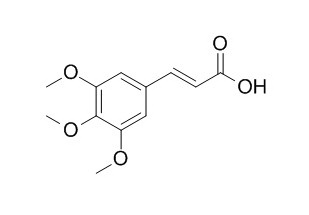3,4,5-Trimethoxycinnamic acid
3,4,5-Trimethoxycinnamic acid has anti-stress effect, prolonging the sleeping time in animals. 3,4,5-Trimethoxycinnamic acid may exert anti-seizure activity by acting at the GABAA/BZ receptor complex. It shows hypoxia inducible factor-2 (HIF-2) inhibitory activity with EC50 value of 60.6 uM. 3,4,5-Trimethoxycinnamic acid derivatives have a potential antinarcotic effect through acting as a 5-HT(1A) receptor agonist in mice.
Inquire / Order:
manager@chemfaces.com
Technical Inquiries:
service@chemfaces.com
Tel:
+86-27-84237783
Fax:
+86-27-84254680
Address:
1 Building, No. 83, CheCheng Rd., Wuhan Economic and Technological Development Zone, Wuhan, Hubei 430056, PRC
Providing storage is as stated on the product vial and the vial is kept tightly sealed, the product can be stored for up to
24 months(2-8C).
Wherever possible, you should prepare and use solutions on the same day. However, if you need to make up stock solutions in advance, we recommend that you store the solution as aliquots in tightly sealed vials at -20C. Generally, these will be useable for up to two weeks. Before use, and prior to opening the vial we recommend that you allow your product to equilibrate to room temperature for at least 1 hour.
Need more advice on solubility, usage and handling? Please email to: service@chemfaces.com
The packaging of the product may have turned upside down during transportation, resulting in the natural compounds adhering to the neck or cap of the vial. take the vial out of its packaging and gently shake to let the compounds fall to the bottom of the vial. for liquid products, centrifuge at 200-500 RPM to gather the liquid at the bottom of the vial. try to avoid loss or contamination during handling.
Int J Mol Sci.2018, 19(9):E2528
Food Res Int.2019, 123:125-134
J Appl Biol Chem.2024, 67:33,238-244
Biochem Pharmacol. 2020, 177:114014.
BMC Complement Altern Med.2019, 19(1):367
Korean J Environ Agric.2018, 37(4):260-267
Journal of Functional Foods2022, 99: 105331.
Molecules.2023, 28(3):958.
Antioxidants (Basel).2021, 10(10):1638.
J Cell Mol Med.2024, 28(16):e70016.
Related and Featured Products
Chem Biol Drug Des. 2013 Mar;81(3):389-98.
Synthesis and evaluation of a series of 3,4,5-trimethoxycinnamic acid derivatives as potential antinarcotic agents.[Pubmed:
23121934]
A series of 3,4,5-Trimethoxycinnamic acid derivatives was prepared and evaluated for antinarcotic effects on morphine dependence in mice and binding affinities on serotonergic receptors.
METHODS AND RESULTS:
The key synthetic strategies involve generation of ketones 6-7, esters 9-12 through condensation reaction, and amides 13-19 via coupling reaction using 1-hydroxybenzotriazole/ethyl(dimethylaminopropryl)carbodiimide system in high yield. We found that the naloxone-induced morphine withdrawal syndrome was significantly suppressed by new synthetic 3,4,5-Trimethoxycinnamic acid derivatives (20 mg/kg/day). Most of 3,4,5-Trimethoxycinnamic acid derivatives were found to have high affinity to 5-HT(1A) receptor. The naloxone-induced morphine withdrawal syndrome was attenuated by (+)8-OH-DPAT (0.1 mg/kg/day, i.p.), a 5-HT(1A) receptor agonist. In cortical neuronal cells, (+)8-OH-DPAT (1 μM) produced an elevation of the pERK 1/2 expression, and the elevated pERK levels were inhibited by WAY 100635, a 5-HT(1A) receptor-specific antagonist. Interestingly, the pERK levels were increased by the 3,4,5-Trimethoxycinnamic acid derivatives and the derivatives-mediated changes in pERK levels were blocked by the WAY 100635.
CONCLUSIONS:
These results suggested that new synthetic 3,4,5-Trimethoxycinnamic acid derivatives have a potential antinarcotic effect through acting as a 5-HT(1A) receptor agonist in mice.
Biol Pharm Bull. 2004 Aug;27(8):1317-9.
Anti-stress effects of 3,4,5-trimethoxycinnamic acid, an active constituent of roots of Polygala tenuifolia (Onji).[Pubmed:
15305046]
3,4,5-Trimethoxycinnamic acid (TMCA) is one of the constituents in Onji (roots of Polygala tenuifolia WILLD), an herbal medicine used for sedative in Japanese traditional Kampo medicine. Our previous study revealed that oral administration of this compound prolongs sleeping time induced by hexobarbital in mice to exhibit sedative action.
METHODS AND RESULTS:
In the present study, we investigate the effects of TMCA on the stress induced with repeated cold exposure or intracerebroventricular injection of corticotrophin-releasing hormone (CRH). Both types of stress significantly reduced the sleeping time induced with pentobarbital in rat, which was significantly prolonged by intraperitoneal injection of TMCA. The intracerebroventricular injection of CRH significantly augmented the content of norepinephrine (NE) in locus coeruleus (LC) of rats, which was significantly suppressed by the intracerebroventricular injection of TMCA.
CONCLUSIONS:
These findings suggest that TMCA would exhibit sedative effects by suppressing NE content in LC.
Arch Pharm Res. 2013 Oct;36(10):1244-51.
3,4,5-Trimethoxycinnamic acid (TMCA), one of the constituents of Polygalae Radix enhances pentobarbital-induced sleeping behaviors via GABAAergic systems in mice.[Pubmed:
23852644]
These experiments were performed to investigate whether 3,4,5-Trimethoxycinnamic acid (TMCA), one of the constituents derived from Polygalae Radix, enhances pentobarbital-induced sleeping behaviors, and to alter sleep architecture through the γ-aminobutyric acid (GABA)ergic systems in mice.
METHODS AND RESULTS:
3,4,5-Trimethoxycinnamic acid decreased the locomotor activity. 3,4,5-Trimethoxycinnamic acid prolonged total sleep time, and reduced sleep latency induced by pentobarbital, similar to muscimol, a GABAA agonist. From the electrocencephalogram recording for 6 h after 3,4,5-Trimethoxycinnamic acid administration, the number of sleep/wake cycles were reduced by 3,4,5-Trimethoxycinnamic acid. 3,4,5-Trimethoxycinnamic acid also increased the total sleep time and non-rapid eye movement (NREM) sleep. In addition, 3,4,5-Trimethoxycinnamic acid increased Cl(-) influx in primary cultured cerebellar granule cells of mice. 3,4,5-Trimethoxycinnamic acid increased the activation of glutamic acid decarboxylase (GAD) and the expressions of γ-subunit of GABAA receptors in the cerebellar granule cells. However, α- and β-subunits proteins of GABAA receptors were not increased. Therefore,3,4,5-Trimethoxycinnamic acid would increase pentobarbital induced-sleep and NREM sleep in mice.
CONCLUSIONS:
These results indicate that 3,4,5-Trimethoxycinnamic acid may enhance sleep and alter sleep architecture through GABAAergic systyems.
Chem Pharm Bull (Tokyo). 2011;59(9):1178-9.
A new hypoxia inducible factor-2 inhibitory pyrrolinone alkaloid from roots and stems of Piper sarmentosum.[Pubmed:
21881266 ]
METHODS AND RESULTS:
A new trimethoxycinnamoyl-2-pyrrolinone alkaloid, langkamide (1), along with the known compounds piplartine (2) and 3,4,5-Trimethoxycinnamic acid (3) were isolated from the roots and stems of the shrub Piper sarmentosum ROXB. The structures were established by spectroscopic analyses and comparison of their spectral data with values reported in the literature.
CONCLUSIONS:
The compounds were tested for their ability to modulate hypoxia inducible factor-2 (HIF-2) transcription activity and all three showed HIF-2 inhibitory activity with EC₅₀ values of 14.0, 4.8, and 60.6 μM, respectively, for compounds 1, 2, and 3.



